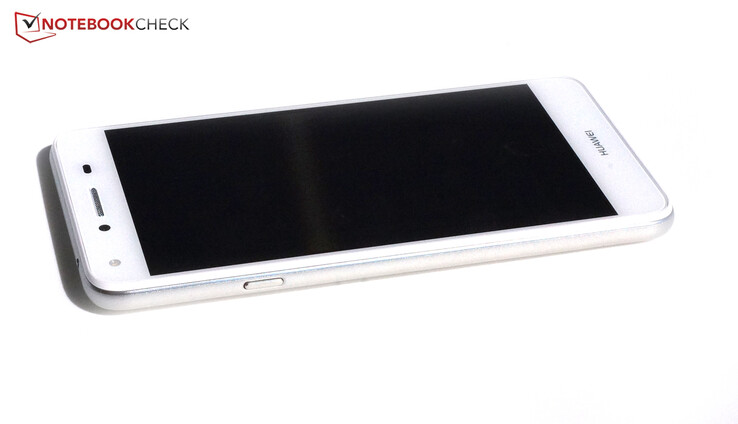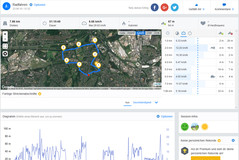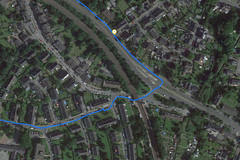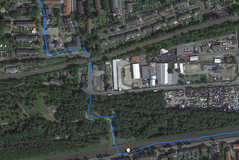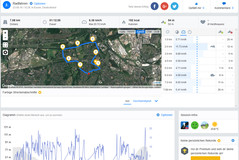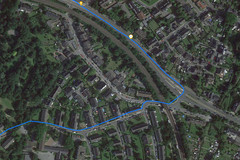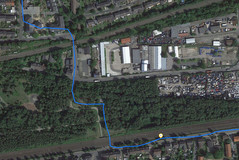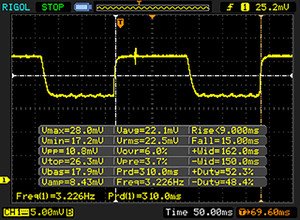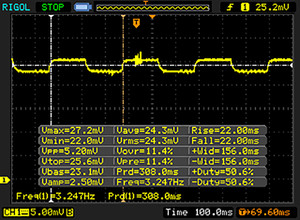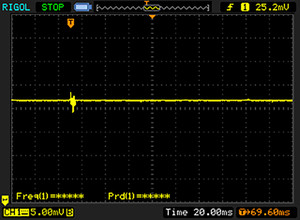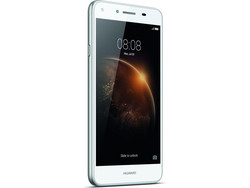Breve análisis del Smartphone Huawei Y6 II Compact
Top 10 Análisis
» Top 10 Portátiles Multimedia
» Top 10 Portátiles de Juego
» Top 10 Portátiles de Juego ligeros
» Top 10 Portátiles Asequibles de Oficina/Empresa
» Top 10 Portátiles de Juego Ligeros
» Top 10 Portátiles de Oficina/Empresa Premium
» Top 10 Estaciones de Trabajo
» Top 10 Subportátiles
» Top 10 Ultrabooks
» Top 10 Convertibles
» Top 10 Tablets
» Top 10 Tablets Windows
» Top 10 Tablets de menos de 250 Euros
» Top 10 Phablets (>5.5")
» Top 10 Smartphones
» Top 10 Smartphones (≤5")
» Top 10 Smartphones de menos de 300 Euros
» Top 10 Smartphones de menos de 120 Euros
» Top 10 Portátiles de menos de 1000 Euros
» Top 10 Portátiles de menos de 500 Euros
» Top 10 Portátiles de menos de 300 Euros
» Los Mejores Displays de Portátiles Analizados por Notebookcheck
| Networking | |
| iperf Server (receive) TCP 1 m | |
| LG G5 | |
| Samsung Galaxy S7 Edge | |
| Honor 5C | |
| Huawei Y6 II Compact | |
| iperf Client (transmit) TCP 1 m | |
| Samsung Galaxy S7 Edge | |
| LG G5 | |
| Honor 5C | |
| Huawei Y6 II Compact | |
| |||||||||||||||||||||||||
iluminación: 92 %
Brillo con batería: 491 cd/m²
Contraste: 546:1 (Negro: 0.9 cd/m²)
ΔE ColorChecker Calman: 6.6 | ∀{0.5-29.43 Ø4.78}
ΔE Greyscale Calman: 4.9 | ∀{0.09-98 Ø5}
Gamma: 2.12
CCT: 7090 K
| Huawei Y6 II Compact IPS, 1280x720, 5" | LG K10 IPS, 1280x720, 5.3" | HTC Desire 530 IPS, 1280x720, 5" | Honor 5C IPS, 1920x1080, 5.2" | Samsung Galaxy J3 2016 Super AMOLED, 1280x720, 5" | |
|---|---|---|---|---|---|
| Screen | 7% | 22% | 14% | -5% | |
| Brightness middle (cd/m²) | 491 | 370 -25% | 375 -24% | 515 5% | 295 -40% |
| Brightness (cd/m²) | 487 | 355 -27% | 376 -23% | 498 2% | 299 -39% |
| Brightness Distribution (%) | 92 | 92 0% | 91 -1% | 93 1% | 96 4% |
| Black Level * (cd/m²) | 0.9 | 0.28 69% | 0.32 64% | 0.49 46% | |
| Contrast (:1) | 546 | 1321 142% | 1172 115% | 1051 92% | |
| Colorchecker dE 2000 * | 6.6 | 6.7 -2% | 6 9% | 6.2 6% | 5.8 12% |
| Colorchecker dE 2000 max. * | 12.9 | 17.8 -38% | 9.5 26% | 11.4 12% | 8.6 33% |
| Greyscale dE 2000 * | 4.9 | 7.9 -61% | 4.5 8% | 7.4 -51% | 4.8 2% |
| Gamma | 2.12 104% | 2.21 100% | 2.26 97% | 2.28 96% | 1.84 120% |
| CCT | 7090 92% | 9072 72% | 6975 93% | 8664 75% | 6252 104% |
* ... más pequeño es mejor
Tiempos de respuesta del display
| ↔ Tiempo de respuesta de Negro a Blanco | ||
|---|---|---|
| 24 ms ... subida ↗ y bajada ↘ combinada | ↗ 9 ms subida | |
| ↘ 15 ms bajada | ||
| La pantalla mostró buenos tiempos de respuesta en nuestros tests pero podría ser demasiado lenta para los jugones competitivos. En comparación, todos los dispositivos de prueba van de ##min### (mínimo) a 240 (máximo) ms. » 53 % de todos los dispositivos son mejores. Eso quiere decir que el tiempo de respuesta es peor que la media (20.2 ms) de todos los dispositivos testados. | ||
| ↔ Tiempo de respuesta 50% Gris a 80% Gris | ||
| 44 ms ... subida ↗ y bajada ↘ combinada | ↗ 22 ms subida | |
| ↘ 22 ms bajada | ||
| La pantalla mostró tiempos de respuesta lentos en nuestros tests y podría ser demasiado lenta para los jugones. En comparación, todos los dispositivos de prueba van de ##min### (mínimo) a 636 (máximo) ms. » 73 % de todos los dispositivos son mejores. Eso quiere decir que el tiempo de respuesta es peor que la media (31.6 ms) de todos los dispositivos testados. | ||
Parpadeo de Pantalla / PWM (Pulse-Width Modulation)
| Parpadeo de Pantalla / PWM no detectado | |||
Comparación: 53 % de todos los dispositivos testados no usaron PWM para atenuar el display. Si se usó, medimos una media de 8108 (mínimo: 5 - máxmo: 343500) Hz. | |||
| AnTuTu v6 - Total Score (ordenar por valor) | |
| Huawei Y6 II Compact | |
| LG K10 | |
| HTC Desire 530 | |
| Honor 5C | |
| Samsung Galaxy J3 2016 | |
| GFXBench (DX / GLBenchmark) 2.7 | |
| T-Rex Onscreen (ordenar por valor) | |
| Huawei Y6 II Compact | |
| LG K10 | |
| HTC Desire 530 | |
| Honor 5C | |
| Samsung Galaxy J3 2016 | |
| 1920x1080 T-Rex Offscreen (ordenar por valor) | |
| Huawei Y6 II Compact | |
| LG K10 | |
| HTC Desire 530 | |
| Honor 5C | |
| Samsung Galaxy J3 2016 | |
| GFXBench 3.0 | |
| on screen Manhattan Onscreen OGL (ordenar por valor) | |
| Huawei Y6 II Compact | |
| LG K10 | |
| HTC Desire 530 | |
| Honor 5C | |
| 1920x1080 1080p Manhattan Offscreen (ordenar por valor) | |
| Huawei Y6 II Compact | |
| LG K10 | |
| HTC Desire 530 | |
| Honor 5C | |
| GFXBench 3.1 | |
| on screen Manhattan ES 3.1 Onscreen (ordenar por valor) | |
| Huawei Y6 II Compact | |
| LG K10 | |
| Honor 5C | |
| 1920x1080 Manhattan ES 3.1 Offscreen (ordenar por valor) | |
| Huawei Y6 II Compact | |
| LG K10 | |
| Honor 5C | |
| PCMark for Android - Work performance score (ordenar por valor) | |
| Huawei Y6 II Compact | |
| LG K10 | |
| HTC Desire 530 | |
| Honor 5C | |
| Samsung Galaxy J3 2016 | |
| Geekbench 4.0 | |
| 64 Bit Single-Core Score (ordenar por valor) | |
| Huawei Y6 II Compact | |
| 64 Bit Multi-Core Score (ordenar por valor) | |
| Huawei Y6 II Compact | |
| Compute RenderScript Score (ordenar por valor) | |
| Huawei Y6 II Compact | |
| Mozilla Kraken 1.1 - Total (ordenar por valor) | |
| Huawei Y6 II Compact | |
| LG K10 | |
| HTC Desire 530 | |
| Honor 5C | |
| Samsung Galaxy J3 2016 | |
| Octane V2 - Total Score (ordenar por valor) | |
| Huawei Y6 II Compact | |
| LG K10 | |
| HTC Desire 530 | |
| Honor 5C | |
| Samsung Galaxy J3 2016 | |
| WebXPRT 2015 - Overall (ordenar por valor) | |
| Huawei Y6 II Compact | |
| LG K10 | |
| HTC Desire 530 | |
| Honor 5C | |
| Samsung Galaxy J3 2016 | |
| JetStream 1.1 - Total Score (ordenar por valor) | |
| Huawei Y6 II Compact | |
| LG K10 | |
| HTC Desire 530 | |
| Honor 5C | |
| Samsung Galaxy J3 2016 | |
* ... más pequeño es mejor
| AndroBench 3-5 | |
| Sequential Read 256KB (ordenar por valor) | |
| Huawei Y6 II Compact | |
| LG K10 | |
| HTC Desire 530 | |
| Honor 5C | |
| Samsung Galaxy J3 2016 | |
| Sequential Write 256KB (ordenar por valor) | |
| Huawei Y6 II Compact | |
| LG K10 | |
| HTC Desire 530 | |
| Honor 5C | |
| Samsung Galaxy J3 2016 | |
| Random Read 4KB (ordenar por valor) | |
| Huawei Y6 II Compact | |
| LG K10 | |
| HTC Desire 530 | |
| Honor 5C | |
| Samsung Galaxy J3 2016 | |
| Random Write 4KB (ordenar por valor) | |
| Huawei Y6 II Compact | |
| LG K10 | |
| HTC Desire 530 | |
| Honor 5C | |
| Samsung Galaxy J3 2016 | |
| Sequential Read 256KB SDCard (ordenar por valor) | |
| Huawei Y6 II Compact | |
| LG K10 | |
| HTC Desire 530 | |
| Honor 5C | |
| Samsung Galaxy J3 2016 | |
| Sequential Write 256KB SDCard (ordenar por valor) | |
| Huawei Y6 II Compact | |
| LG K10 | |
| HTC Desire 530 | |
| Honor 5C | |
| Samsung Galaxy J3 2016 | |
| Asphalt 8: Airborne | |||
| Configuraciones | Valor | ||
| high | 24 fps | ||
| very low | 30 fps | ||
| Dead Trigger 2 | |||
| Configuraciones | Valor | ||
| high | 29 fps | ||
(±) La temperatura máxima en la parte superior es de 45 °C / 113 F, frente a la media de 35.2 °C / 95 F, que oscila entre 21.9 y 247 °C para la clase Smartphone.
(±) El fondo se calienta hasta un máximo de 42.2 °C / 108 F, frente a la media de 34 °C / 93 F
(±) En reposo, la temperatura media de la parte superior es de 35 °C / 95# F, frente a la media del dispositivo de 32.9 °C / 91 F.
Huawei Y6 II Compact análisis de audio
(+) | los altavoces pueden reproducir a un volumen relativamente alto (#86.4 dB)
Graves 100 - 315 Hz
(-) | casi sin bajos - de media 31% inferior a la mediana
(±) | la linealidad de los graves es media (7.3% delta a frecuencia anterior)
Medios 400 - 2000 Hz
(±) | medios reducidos - de media 7.7% inferior a la mediana
(±) | la linealidad de los medios es media (11.7% delta respecto a la frecuencia anterior)
Altos 2 - 16 kHz
(±) | máximos más altos - de media 13.4% más altos que la mediana
(+) | los máximos son lineales (5.9% delta a la frecuencia anterior)
Total 100 - 16.000 Hz
(-) | el sonido global no es lineal (35.6% de diferencia con la mediana)
En comparación con la misma clase
» 85% de todos los dispositivos probados de esta clase eran mejores, 1% similares, 14% peores
» El mejor tuvo un delta de 11%, la media fue 35%, el peor fue ###max##%
En comparación con todos los dispositivos probados
» 93% de todos los dispositivos probados eran mejores, 1% similares, 6% peores
» El mejor tuvo un delta de 4%, la media fue 24%, el peor fue ###max##%
Samsung Galaxy S7 análisis de audio
(+) | los altavoces pueden reproducir a un volumen relativamente alto (#87.4 dB)
Graves 100 - 315 Hz
(-) | casi sin bajos - de media 25.2% inferior a la mediana
(±) | la linealidad de los graves es media (9.2% delta a frecuencia anterior)
Medios 400 - 2000 Hz
(+) | medios equilibrados - a sólo 4.1% de la mediana
(+) | los medios son lineales (5% delta a la frecuencia anterior)
Altos 2 - 16 kHz
(±) | máximos más altos - de media 6.6% más altos que la mediana
(+) | los máximos son lineales (6.3% delta a la frecuencia anterior)
Total 100 - 16.000 Hz
(±) | la linealidad del sonido global es media (20.9% de diferencia con la mediana)
En comparación con la misma clase
» 38% de todos los dispositivos probados de esta clase eran mejores, 8% similares, 54% peores
» El mejor tuvo un delta de 11%, la media fue 35%, el peor fue ###max##%
En comparación con todos los dispositivos probados
» 56% de todos los dispositivos probados eran mejores, 8% similares, 36% peores
» El mejor tuvo un delta de 4%, la media fue 24%, el peor fue ###max##%
| Off / Standby | |
| Ocioso | |
| Carga |
|
Clave:
min: | |
| Huawei Y6 II Compact 2200 mAh | Samsung Galaxy J3 2016 2600 mAh | Honor 5C 3000 mAh | HTC Desire 530 2200 mAh | |
|---|---|---|---|---|
| Power Consumption | 8% | -28% | -79% | |
| Idle Minimum * (Watt) | 0.57 | 0.96 -68% | 0.89 -56% | 1.58 -177% |
| Idle Average * (Watt) | 1.53 | 1.14 25% | 2.07 -35% | 2.59 -69% |
| Idle Maximum * (Watt) | 1.6 | 1.23 23% | 2.15 -34% | 2.66 -66% |
| Load Average * (Watt) | 2.82 | 2.45 13% | 3.46 -23% | 5.22 -85% |
| Load Maximum * (Watt) | 5.69 | 2.92 49% | 5.18 9% | 5.67 -0% |
* ... más pequeño es mejor
| Huawei Y6 II Compact 2200 mAh | LG K10 2300 mAh | HTC Desire 530 2200 mAh | Honor 5C 3000 mAh | Samsung Galaxy J3 2016 2600 mAh | |
|---|---|---|---|---|---|
| Duración de Batería | -10% | -14% | -16% | 16% | |
| Reader / Idle (h) | 19.6 | 18.7 -5% | 18.6 -5% | 16.6 -15% | 20.2 3% |
| H.264 (h) | 11.4 | 10.1 -11% | 7.6 -33% | 10 -12% | 9.8 -14% |
| WiFi v1.3 (h) | 10.4 | 7.6 -27% | 7.1 -32% | 9.7 -7% | 8.4 -19% |
| Load (h) | 3.7 | 3.9 5% | 4.2 14% | 2.6 -30% | 7.2 95% |
Pro
Contra
El Huawei Y6 II Compact tiene tres competencias principales clarísimas: rendimiento, aguante de batería, y precio. El modelo de pruebas está muy bien equipado en esos tres sectores, pero las otras áreas como la mala cámara y la pantalla de bajo contraste palidecen claramente.
Aunque la carcasa sea de plástico, la trasera texturizada y la impecable construcción dan una impresión de calidad. Además, muchos extras como dual-SIM, micro-SD, USB OTG, radio, y LTE están presentes. El malísimo altavoz, el sistema operativo desfasado, y las elevadas temperaturas están al otro lado.
Los puntos en los que se centra Huawei en este smartphone son muy obvios - una relación precio-rendimiento decente y un buen aguante de batería. Sin embargo, los otros aspectos del smartphone se han descuidado, algunos hasta un punto reprobable.
Los usuarios a los que les guste el diseño y sencillamente quieran un smartphone asequible y bastante potente pueden plantearse el Huawei Y6 II Compact. Sin embargo, la cámara no debe ser un aspecto clave, ni tampoco una pantalla colorida o un buen altavoz.
Ésta es una versión acortada del análisis original. Puedes leer el análisis completo en inglés aquí.
Huawei Y6 II Compact
- 09/13/2016 v5.1 (old)
Florian Wimmer




